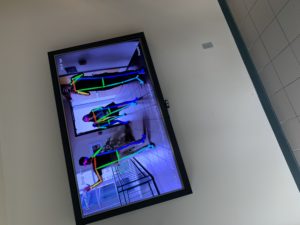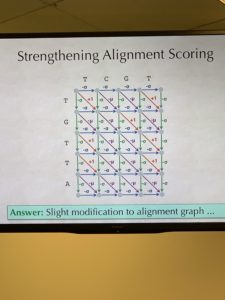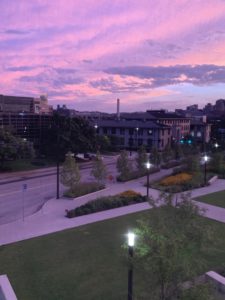Hello everyone, I just finished up my second week studying computational biology at CMU.
This week was an exceptional one and I’m really excited to tell you all about the awesome things I got to do. This week was mostly split between time in the microbiology lab, time in the computer lab and free time, so I’m going to focus in on those three aspects of my internship for this blog.
First and foremost, let’s talk about the microbiology lab. This is a place where I don’t have much experience so I was really impressed with how much I was allowed to do. Mentor Josh took a very hands off approach and told us to prepare and execute pretty much every experiment ourselves. I don’t have space in this blog to explain all of the different things we did, so I’ll focus on just two of them that I consider particularly cool: the PCR reaction and Gel Electrophoresis. PCR stands for Polymerase Chain Reaction. It essentially allows you to make a great many copies of a specific section of DNA. By binding primers to each end of the section you want to replicate and placing an enzyme called Taq Polymerase in the environment, that section (and that section only) is replicated. You can then repeat this process many times over to get as many copies as you want of a particular section of DNA. I unfortunately don’t have pictures (see week 1’s blog) but while it was loads of fun it wasn’t very interesting to look at with the naked eye so you aren’t missing out on too much. Gel Electrophoresis was the lab we did immediately after the PCR experiment and it was also very interesting. It allows you to separate your different PCR sections by size so that you know the reaction worked how you wanted it too. It uses Electromagnetism to drag DNA through a gel and longer strands have a harder time getting through and get stuck at a particular place. For example, if you expected to replicate a piece of DNA about 1200 base pairs long then there should be a bright band at a particular point in the gel. It’s difficult to faithfully describe without examples, but there are plenty of resources online that can tell you more if you’re interested.
Now on to the computer lab. This was probably my favorite part of each day since I really enjoy the logical challenge that comes with it, but it does require some background knowledge that I am unqualified to provide. Again, there are some wonderful resources online that can teach you this stuff, but I’ll do what I can here. What we were doing this week mostly has to do with string comparison. This is the process of taking two or more different strings (which are groups of letters, numbers, punctuation etc… like a sentence or word) and then doing things to pick out the differences and similarities and manipulating them in various ways. This is a HUGE deal for computational biology for man different reasons, possibly the biggest of which is Genome Assembly. Most of you will probably have heard of the human genome project or are aware of other cases where researchers have figured out the genetic code of various organisms, but most people don’t know just how difficult that process is even today. The only way we can currently read genetic code is with “reads” which are short sections of DNA that could have come from any place in the genome. They tend to be only a few hundred base pairs long, compared to the whole genome which can be hundreds of billions of base pairs long in some cases. My wonderful instructor Philip compared it to taking a giant stack of todays newspaper and lighting a stick of dynamite underneath it, then trying to make a single newspaper out of the pieces. If anything, he was understating it. Reconstructing those reads into a single genome is a huge challenge, but by last Friday I was able to program, from scratch, a piece of code that could assemble a complete genome. It was an incredible achievement for me and has given me a new respect for the people who make the real software to do this.
Finally, free time. This week came at a frantic pace and I couldn’t have loved it more. My friends and I set up a movie in one of  the big auditoriums on campus (which students are apparently allowed to use whenever there isn’t a class happening) and sang karaoke in the same place. We went to Kennywood amusement park and screamed on the various rollercoasters and carnival rides. We’ve played squash and chess and gone to the gym. We played card games and board games and video games and went to meals and activities. Just today we went to a community pool and had a blast launching each other in the air and stacking ourselves three high on each others shoulders. Its been incredible and I can honestly say that I will look back on these weeks as some of the most fun I’ve ever had.
the big auditoriums on campus (which students are apparently allowed to use whenever there isn’t a class happening) and sang karaoke in the same place. We went to Kennywood amusement park and screamed on the various rollercoasters and carnival rides. We’ve played squash and chess and gone to the gym. We played card games and board games and video games and went to meals and activities. Just today we went to a community pool and had a blast launching each other in the air and stacking ourselves three high on each others shoulders. Its been incredible and I can honestly say that I will look back on these weeks as some of the most fun I’ve ever had.
I’ll see you all next week, hopefully with even more stories to tell.



Awesome!
-Cousin Jackson
Way over my head. Now if you want to talk automatic transmission rebuilds, I’m your guy.
Rick of “Adele and Rick”
AMAZING!!!!!
Treble awesome and I love the analogy with the stack of newspapers;must try that, the only bit I understood apart from the fun week which does appeal plus plus..
All the best,
Friend of Uncle Ray